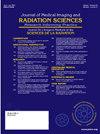Explainable artificial intelligence for pneumonia classification: Clinical insights into deformable prototypical part network in pediatric chest x-ray images
IF 1.3
Q3 RADIOLOGY, NUCLEAR MEDICINE & MEDICAL IMAGING
Journal of Medical Imaging and Radiation Sciences
Pub Date : 2025-07-11
DOI:10.1016/j.jmir.2025.102023
引用次数: 0
Abstract
Background
Pneumonia detection in chest X-rays (CXR) increasingly relies on AI-driven diagnostic systems. However, their “black-box” nature often lacks transparency, underscoring the need for interpretability to improve patient outcomes. This study presents the first application of the Deformable Prototypical Part Network (D-ProtoPNet), an ante-hoc interpretable deep learning (DL) model, for pneumonia classification in pediatric patients' CXR images. Clinical insights were integrated through expert radiologist evaluation of the model's learned prototypes and activated image patches, ensuring that explanations aligned with medically meaningful features.
Methods
The model was developed and tested on a retrospective dataset of 5,856 CXR images of pediatric patients, ages 1–5 years. The images were originally acquired at a tertiary academic medical center as part of routine clinical care and were publicly hosted on a Kaggle platform. This dataset comprised anterior-posterior images labeled normal, viral, and bacterial. It was divided into 80 % training and 20 % validation splits, and utilised in a supervised five-fold cross-validation. Performance metrics were compared with the original ProtoPNet, utilising ResNet50 as the base model. An experienced radiologist assessed the clinical relevance of the learned prototypes, patch activations, and model explanations.
Results
The D-ProtoPNet achieved an accuracy of 86 %, precision of 86 %, recall of 85 %, and AUC of 93 %, marking a 3 % improvement over the original ProtoPNet. While further optimisation is required before clinical use, the radiologist praised D-ProtoPNet's intuitive explanations, highlighting its interpretability and potential to aid clinical decision-making.
Conclusion
Prototypical part learning offers a balance between classification performance and explanation quality, but requires improvements to match the accuracy of black-box models. This study underscores the importance of integrating domain expertise during model evaluation to ensure the interpretability of XAI models is grounded in clinically valid insights.
可解释的肺炎分类人工智能:儿童胸部x线图像中可变形的原型部分网络的临床见解
胸部x光(CXR)中的肺炎检测越来越依赖于人工智能驱动的诊断系统。然而,它们的“黑箱”性质往往缺乏透明度,强调了可解释性以改善患者预后的必要性。本研究首次提出了可变形原型部分网络(D-ProtoPNet)的应用,这是一种预先可解释的深度学习(DL)模型,用于儿科患者CXR图像中的肺炎分类。通过放射科专家对模型学习的原型和激活的图像补丁的评估,整合了临床见解,确保解释与医学上有意义的特征保持一致。方法建立该模型,并在5856张1-5岁儿童CXR图像的回顾性数据集上进行测试。这些图像最初是在一家三级学术医疗中心获得的,作为常规临床护理的一部分,并公开托管在Kaggle平台上。该数据集包括标记为正常、病毒和细菌的前后图像。它被分为80个 %训练和20个 %验证分割,并在监督五倍交叉验证中使用。使用ResNet50作为基本模型,将性能指标与原始ProtoPNet进行比较。一位经验丰富的放射科医生评估了学习到的原型、贴片激活和模型解释的临床相关性。结果D-ProtoPNet的准确率为86 %,精密度为86 %,召回率为85 %,AUC为93 %,比原ProtoPNet提高了3 %。虽然在临床使用之前需要进一步优化,但放射科医生赞扬了D-ProtoPNet的直观解释,强调了其可解释性和帮助临床决策的潜力。结论原型零件学习在分类性能和解释质量之间取得了平衡,但需要改进以匹配黑箱模型的准确性。本研究强调了在模型评估过程中整合领域专业知识的重要性,以确保XAI模型的可解释性以临床有效的见解为基础。
本文章由计算机程序翻译,如有差异,请以英文原文为准。
求助全文
约1分钟内获得全文
求助全文
来源期刊

Journal of Medical Imaging and Radiation Sciences
RADIOLOGY, NUCLEAR MEDICINE & MEDICAL IMAGING-
CiteScore
2.30
自引率
11.10%
发文量
231
审稿时长
53 days
期刊介绍:
Journal of Medical Imaging and Radiation Sciences is the official peer-reviewed journal of the Canadian Association of Medical Radiation Technologists. This journal is published four times a year and is circulated to approximately 11,000 medical radiation technologists, libraries and radiology departments throughout Canada, the United States and overseas. The Journal publishes articles on recent research, new technology and techniques, professional practices, technologists viewpoints as well as relevant book reviews.
 求助内容:
求助内容: 应助结果提醒方式:
应助结果提醒方式:


